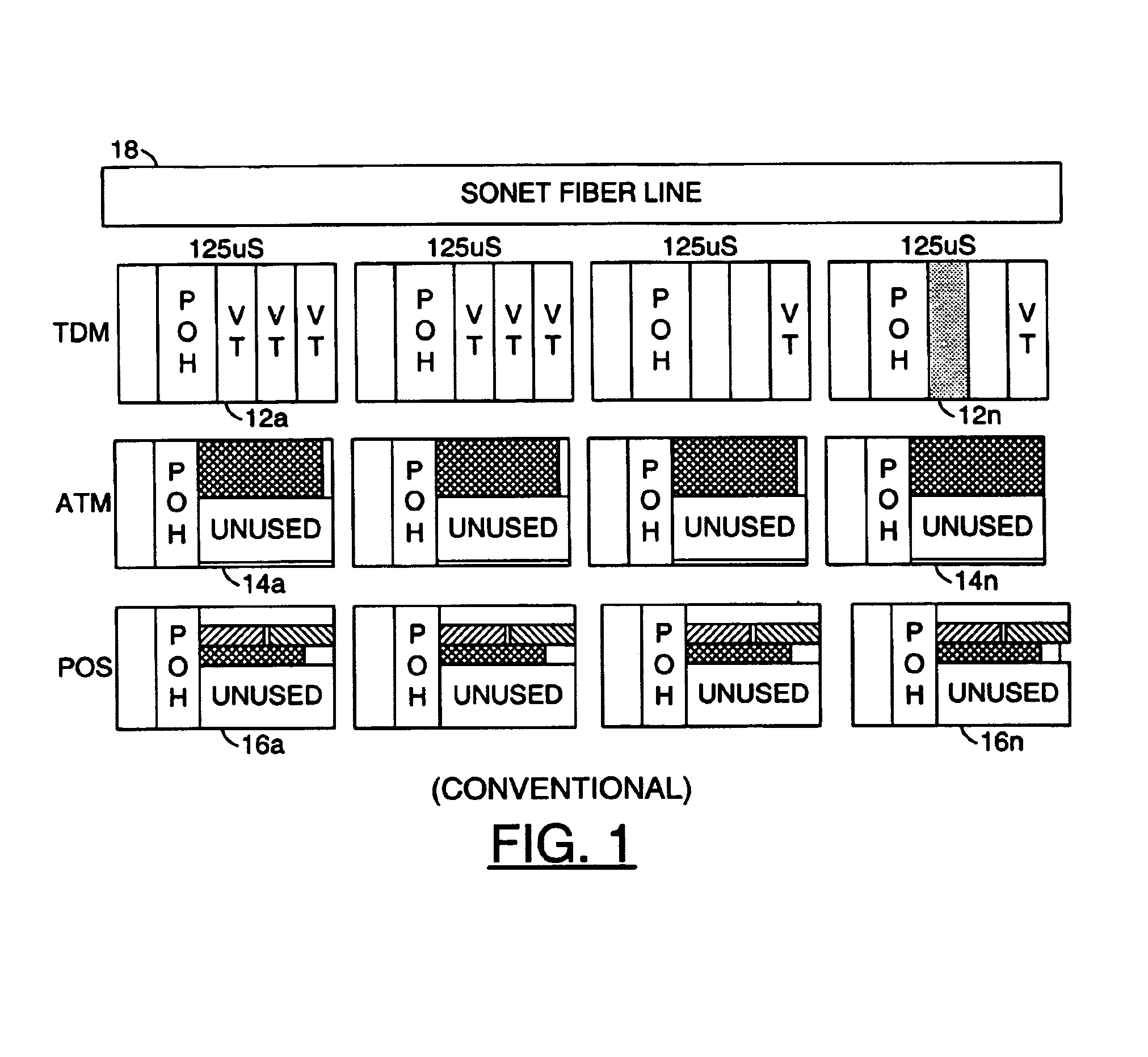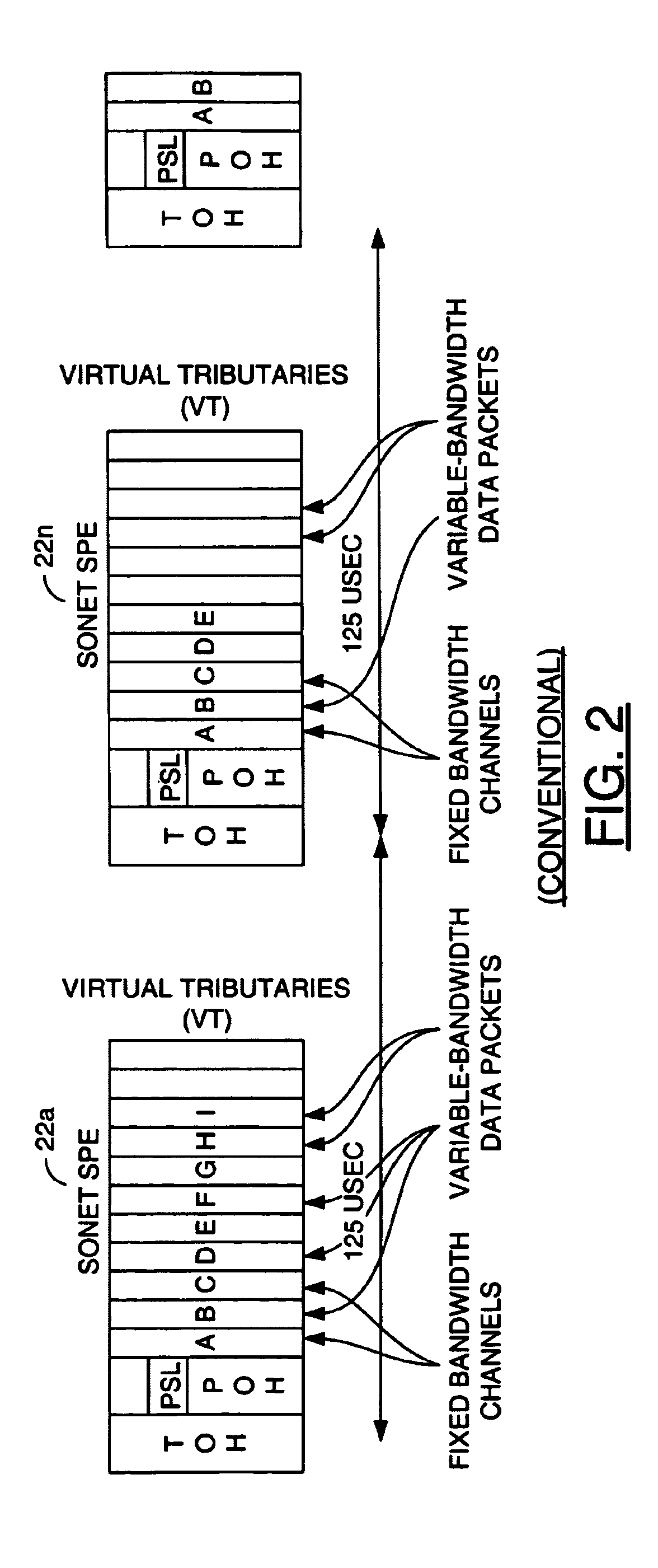The synchronous framing structure of SONET / SDH that is quite efficient for carrying T1 / T3 channels is not able to carry both fixed-bandwidth and variable-bandwidth channels in an optimum way.
SONET / SDH has an inefficient utilization of fiber bandwidth for data packets.
SONET / SDH lacks of support for data mixing.
A SONET fiber link carrying frames containing ATM cells cannot carry POS, because ATM cells frequently carry QoS-sensitive data such as CES (
Circuit Emulation Service) or
multimedia traffic.
Introduction of SONET frames containing POS will cause significant delays (e.g., 125 μS for each POS frame inserted in the link).
This method can only support variable-length packet protocol such as IP.
The reason for this limitation is that each SONET SPE containing IP packets, for example, introduces a
delay of 125 microseconds.
Such a
delay is not acceptable for T1 / T3 circuits or real-time streams using ATM cells.
This requires complex implementations in hardware and incorporation of ATM service interworking at each service boundary.
If the slots B / D / F / G / H / I are used for variable-length data packets, the slots cannot be fully used because the fixed bandwidth slots, such as C and E, do not allow the packets to continue without fragmenting while crossiing slot boundaries.
Allocation of bandwidth for LAN data (such as 10 / 100 Mbps
Ethernet) using a SONET
fiber network and VT becomes difficult.
However,
virtual concatenation has one or more of the following disadvantages:(i)
virtual concatenation allocates a fixed bandwidth for LAN, but cannot dynamically adjust bandwidth usage on a packet-by-packet basis;(ii) bursty LAN traffic bandwidth usage is typically quite low, which can result in significant waste when used over a fixed bandwidth
pipe (e.g., the average use of a 10 Mbps link is 20% and, if an entire STS-1 is used, the efficiency becomes about 4%); and / or(iii) while some virtual
pipe may be overloaded with traffic others may be underused (i.e.,
virtual concatenation cannot dynamically adjust network loads on different channels).
In particular, bandwidth needs to be reserved in advance and all of the available bandwidth is not
usable.
In particular, inverse
multiplexing suffers from one or more of the following disadvantages:(i) inverse
multiplexing allocates a fixed bandwidth for LAN, but cannot dynamically adjust bandwidth usage on a packet-by-packet basis; and / or(ii) bursty LAN traffic bandwidth usage is typically quite low, resulting in a significant waste when used over a fixed bandwidth
pipe (e.g., if the average use of a 10 Mbps link is 20% and if an entire STS-1 is used, then the efficiency becomes about 4%).
Therefore, the bandwidth cannot be dynamically adjusted on different VT channels.
ATM VP multiplexing suffers from one or more of the following disadvantages:(i) operations, administration and maintenance (OAM) operations of an ATM network are different from that of a SONET network, and management of the two networks can become difficult;(ii) ATM
network routing and switch-to-switch signaling of data paths are different from IP network routes, resulting in network
operational complexity; and / or(iii) a high percentage of network traffic consists of IP packets with small packet sizes of around 40 bytes.
Such an excess results in transmission of two ATM cells, with the second
cell that is mostly ATM overhead and stuffing bytes.
Furthermore, the SONET ring 30 cannot
handle T1 or T3 channels entirely in a
payload space.
Because higher-speed concatenated SONET frames are large in size, many times a SONET SPE may not be completely filled with packets or cells at the origin.
Because a SONET SPE carries only one type of data, the originating SONET node or other nodes downstream will not be able to add any different type of data to the SPE, and the SONET frame may be heavily underutilized.
Such an under-utilization of the SONET frame degrades the overall
bandwidth utilization of fiber capacity with SONET / SDH.
While virtual tributaries provide an efficient way to transport PDH traffic, allocation of bandwidth for LAN data such as 10 / 100 Mbps using a SONET fiber containing T1 traffic becomes difficult.
Virtual tributaries cannot dynamically adjust bandwidth usage on a packet-by-packet basis.
While it is possible to change the concatenated bandwidth through
software, such an implementation does not yield much for
bandwidth utilization.
Bursty LAN traffic bandwidth usage is typically quite low, resulting in significant waste when used over a fixed bandwidth virtual pipe (average use of a 10 Mbps link is 20%, and if an entire STS-1 is used the efficiency becomes about 4%).
Another problem with virtual
concatenation is that while one virtual pipe may be overloaded with traffic, others may be underutilized.
However, operations, administration and maintenance (OAM) operations of ATM networks are different from that of SONET, and management of the two protocols can become difficult.
This, with other ATM overheads, means having to allocate extra SONET bandwidth for IP transport if ATM is used as a transport protocol.
Such implementation requires a high level of complexity in hardware and
software, resulting in higher costs of manufacturing and operation of networks.
Such conventional network architectures are not efficient for transmitting variable-length IP packets that form the majority of data network traffic on
the Internet.
Limitations of conventional approaches include one or more of the following (i) inability to mix TDM channels with packet-oriented data over SONET / SDH rings due to timing constraints of the TDM channels without a fixed bandwidth virtual
tributary mechanism and (ii) limiting data channels sent on fiber carrying T1 lines to Virtual tributaries (since virtual tributaries are of fixed bandwidth, this restriction limits data channels to fixed bandwidth operation).
Therefore, if a SONET SPE is carrying all ATM cells, it cannot carry IP variable-length packets, and vice versa.
Conventional approaches do not take into account network loading conditions and do not support dynamic
bandwidth provisioning.
Transporting IP traffic over virtual
tributary channels that was originally designed for DS0 / 1 / 3
connectivity is inefficient.
Because VT assignment is fixed, IP transport is not able to take
advantage of total available SONET / SDH bandwidth.
Conventional approaches have the following disadvantages (i) ATM and Packets are implemented on different rings because of QoS and timing issues; (ii) very high cost for new fiber and SONET equipment for Telco / ISP / MAN; (iii) only one type of packet goes inside a SONET SPE at one time (the remaining bytes of the frame with conventional SONET are wasted) (SONET packets go around the entire SONET ring, limiting bandwidth); and / or (iv) the only way to support
telephony channels along with data packets is to allocated part of SONET frame for packet data transmissions (which results in an inefficient bandwidth usage).
 Login to View More
Login to View More  Login to View More
Login to View More 


